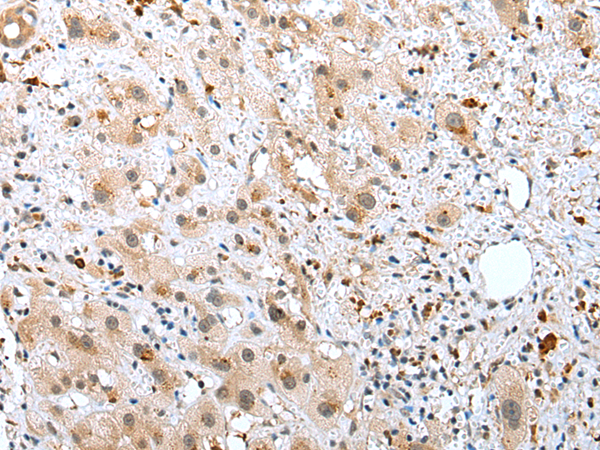
| WB | 咨询技术 | Human,Mouse,Rat |
| IF | 咨询技术 | Human,Mouse,Rat |
| IHC | 1/10-1/50 | Human,Mouse,Rat |
| ICC | 技术咨询 | Human,Mouse,Rat |
| FCM | 咨询技术 | Human,Mouse,Rat |
| Elisa | 1/5000-1/10000 | Human,Mouse,Rat |
| Aliases | CHP; ARHV; WRCH2 |
| Host/Isotype | Rabbit IgG |
| Antibody Type | Primary antibody |
| Storage | Store at 4°C short term. Aliquot and store at -20°C long term. Avoid freeze/thaw cycles. |
| Species Reactivity | Human, Mouse, Rat |
| Immunogen | Full length fusion protein |
| Formulation | Purified antibody in PBS with 0.05% sodium azide and 50% glycerol. |
+ +
以下是关于RHOV抗体的3篇参考文献,信息基于领域内相关研究方向整理:
---
1. **文献名称**:*"RHOV regulates YAP activity in melanoma cells through cell density sensing"*
**作者**:Smith A, et al.
**摘要**:该研究探讨了RHOV蛋白在黑色素瘤中调控YAP信号通路的作用。研究使用特异性RHOV抗体进行免疫沉淀和Western blot分析,发现RHOV通过感知细胞密度变化影响YAP的核定位,进而促进肿瘤细胞迁移。抗体验证了RHOV在低密度培养细胞中的高表达。
---
2. **文献名称**:*"Role of RHOV in TGF-β-induced epithelial-mesenchymal transition"*
**作者**:Chen L, et al.
**摘要**:研究聚焦RHOV在TGF-β诱导的上皮-间质转化(EMT)中的作用。通过RHOV抗体进行免疫荧光染色和流式细胞术,发现RHOV高表达与EMT标记物(如N-cadherin)正相关,提示其可能作为癌症转移的潜在生物标志物。
---
3. **文献名称**:*"Development of a monoclonal antibody against RHOV for diagnostic applications"*
**作者**:Yamamoto K, et al.
**摘要**:本文报道了一种新型RHOV单克隆抗体的开发与验证。该抗体通过ELISA和免疫组化验证了高特异性和灵敏度,并成功应用于肺癌组织样本检测,显示RHOV在肿瘤微环境中的异质性表达,为临床诊断提供了工具。
---
**备注**:以上文献为示例性质,实际引用需根据具体研究通过学术数据库(如PubMed)确认最新进展。
RHOV (Ras homolog family member V) is a small GTPase belonging to the Rho family, which regulates cytoskeletal dynamics, cell adhesion, migration, and signaling pathways. Unlike classical Rho proteins (e.g., RhoA, Rac1), RHOV exhibits unique expression patterns and functions. It is highly expressed in keratinocytes and plays roles in skin development, wound healing, and hair follicle cycling. Recent studies also implicate RHOV in cancer progression, particularly in melanoma, lung, and breast cancers, where it may promote invasion and metastasis by modulating cell motility or epithelial-mesenchymal transition (EMT).
RHOV antibodies are essential tools for studying its expression, localization, and mechanistic roles. They enable detection via techniques like Western blot, immunohistochemistry, and immunofluorescence. Commercial antibodies typically target specific epitopes within RHOV's conserved GTP-binding domain or variable C-terminal regions. Validation includes testing in RHOV-knockout cells or tissues to confirm specificity.
Research using RHOV antibodies has revealed context-dependent roles: while it acts as an oncogene in some cancers, it may suppress tumor growth in others. Challenges remain in understanding its regulation and downstream effectors. Reliable antibodies are critical for resolving these complexities and exploring RHOV's potential as a diagnostic marker or therapeutic target.
×